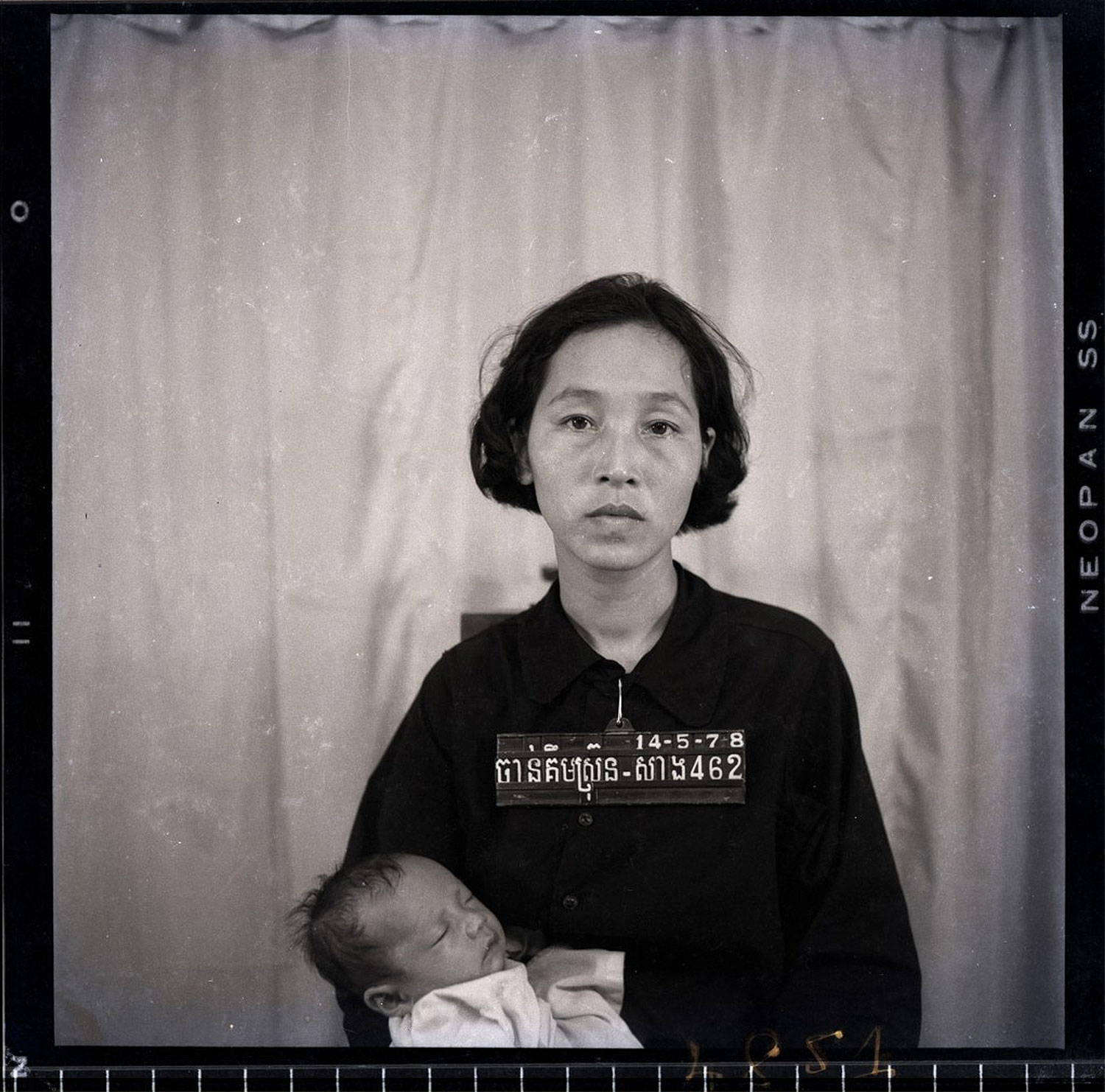Pol Pot
There was such a lawfully elected president communist leader in Cambodia, Pol Pot. The level of psychopathy of this maniac is sometimes difficult to compare even with Hitler himself. In just four years, Pol Pot managed to eliminate almost half of the country’s population, plunging poor Cambodia into the Stone Age.
But unlike Hitler, who simply shot himself out of despair, Pol Pot is a magnificent example of an evil genius, a true diamond! He not only slaughtered several million people but also survived after his overthrow. And not just survived, but lived up to our days. He even gave a few interviews, allowing us to look into his eyes so that we could read the answer to the question: why?
⁂
While the war between the North and the South was raging in Vietnam, a powerful movement with the amusing name “Khmer Rouge” was gaining strength in the forests of neighboring Cambodia. However, they had been Khmers for a long time because once upon a time, the great Khmer Empire flourished in the area that now encompasses modern-day Cambodia, Vietnam, Thailand, and Laos. But they became “red” in the 20th century when they suddenly embraced the popular back then ideology of communism. And that’s when everything went south for the ancient civilization.
Around the same time when the Vietnamese communists captured the city of Saigon, the Khmer Rouge reached the capital of their native Cambodia, the urban municipality of Phnom Penh, and overthrew the pro-American leader Lon Nol there.
By that time, Phnom Penh was flooded with refugees from across the country due to the civil war, and the entire population was barely surviving thanks to the United States’ humanitarian aid deliveries interspersed with flatbread airstrikes. Therefore, the residents of Phnom Penh were thrilled when the Khmer Rouge came to save them. The Khmer Rouge were even more delighted: they had finally found where all the party traitors had fled.
On April 17, 1975, the Khmer Rouge entered Phnom Penh. By April 20, there was no one left in Phnom Penh except for the Khmer Rouge. Two and a half million people were lined up at gunpoint and forcibly expelled from the city to the helluva mother. Every single one of them. On foot.
After Phnom Penh, the relocation of other cities began. Hundreds of thousands of people, including pregnant women, elderly, disabled, and children, walked for many kilometers through the country to reach rice fields. It is worth noting that Cambodia is mostly jungle, including many malaria-infested forests, where the temperature remains around 35 degrees Celsius all year round, and the humidity is suffocating. It is unclear how Angkor was once built in such conditions: after just a couple of hours of wandering freely among the ruins, you don’t know where to escape from the heat. And there’s nowhere to go. Therefore, perhaps the first million victims of Pol Pot were formed even before his full-fledged activities began because nearly half of the displaced people simply died on the way from hunger, suffocation, and sunburn. Well, they were also shot a little.
Actually, Pol Pot appeared in Phnom Penh only a week later when he was convinced that only his army and party leadership remained in the city. In principle, there is nothing more to add. This alone speaks of extreme paranoia. Is it necessary to mention that the world only became aware of Pol Pot’s identity two years after seizing the country? His first photograph was taken during a visit to Beijing as part of a bloody genocide cultural exchange program.
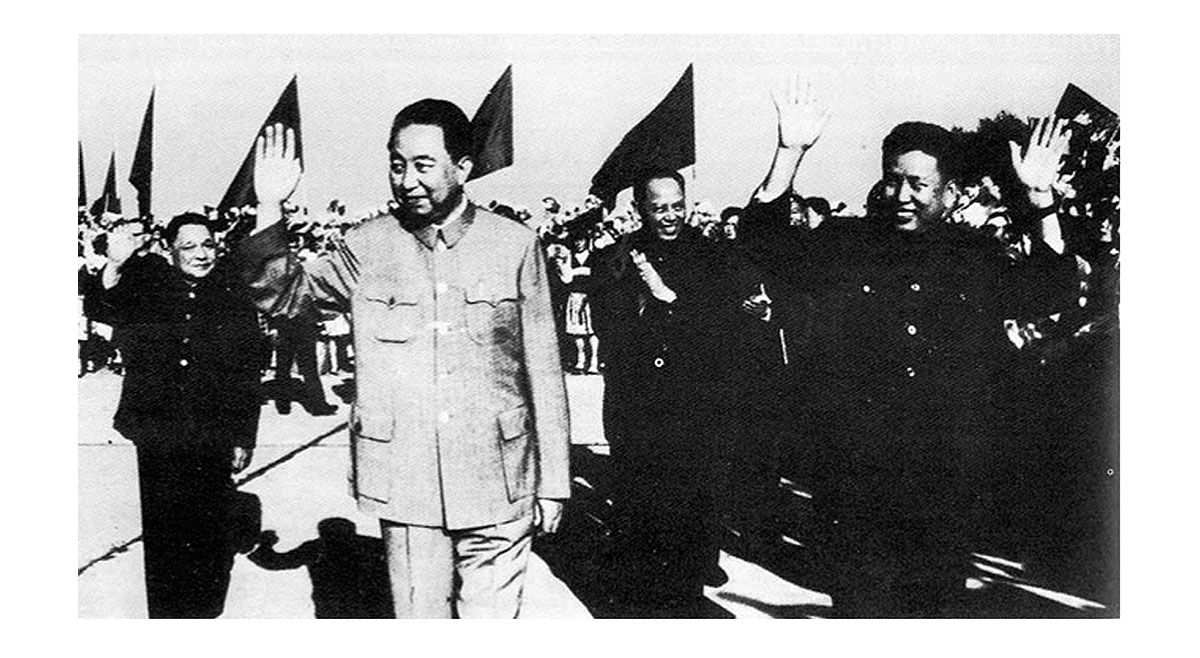
It was that very moment, when the relatives of Saloth Sar, a schoolteacher who disappeared twenty years ago in the jungles, holycowed.
⁂
So, these are human skulls.
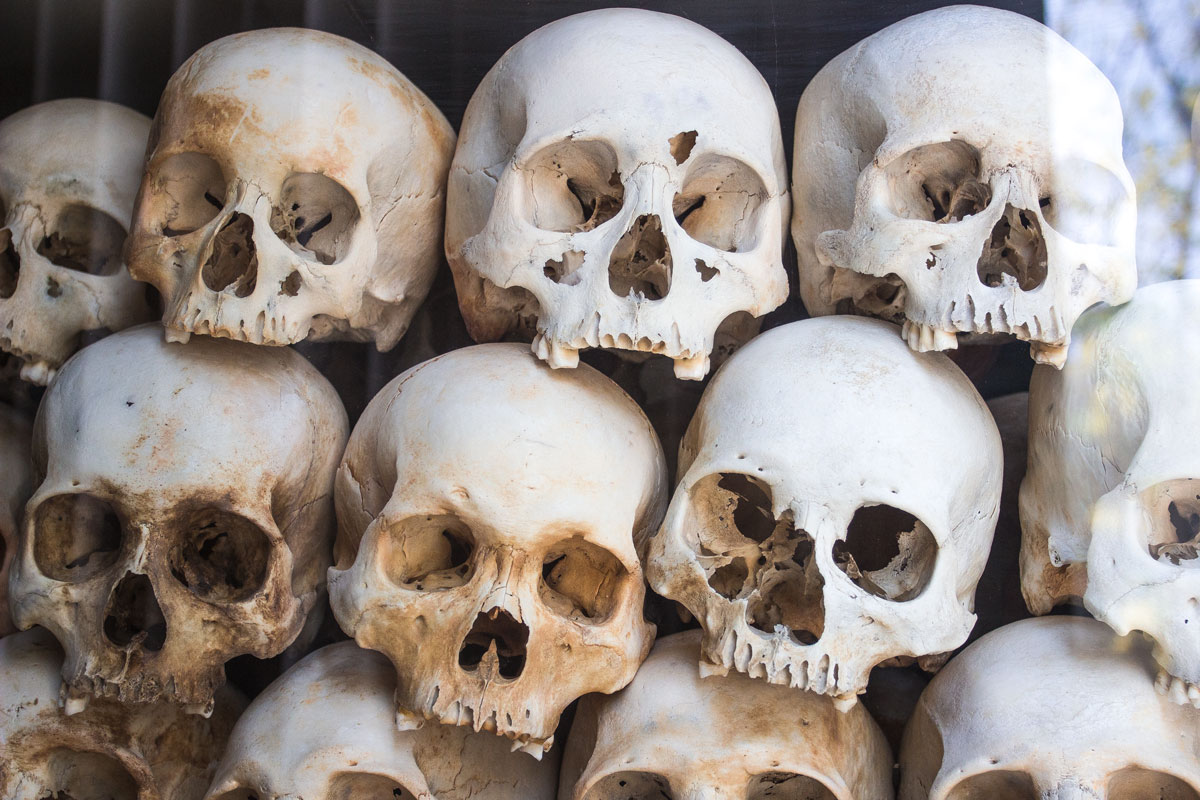
On each skull, there is a colored circle. Each color represents the means of murder.



This place is called the “Killing Fields.” And there are many skulls here.

Very many.

The term “Killing Fields” is a collective name for many locations in Cambodia where the Khmer Rouge gathered and exterminated people. We are currently at one of these sites, just 15 kilometers away from Phnom Penh. It used to be a fruit orchard. Later, 9,000 people were killed here.

In the center of the field stands a Buddhist stupa that is 60 meters tall. From the ground up to half of its height, it is filled with skulls of victims.
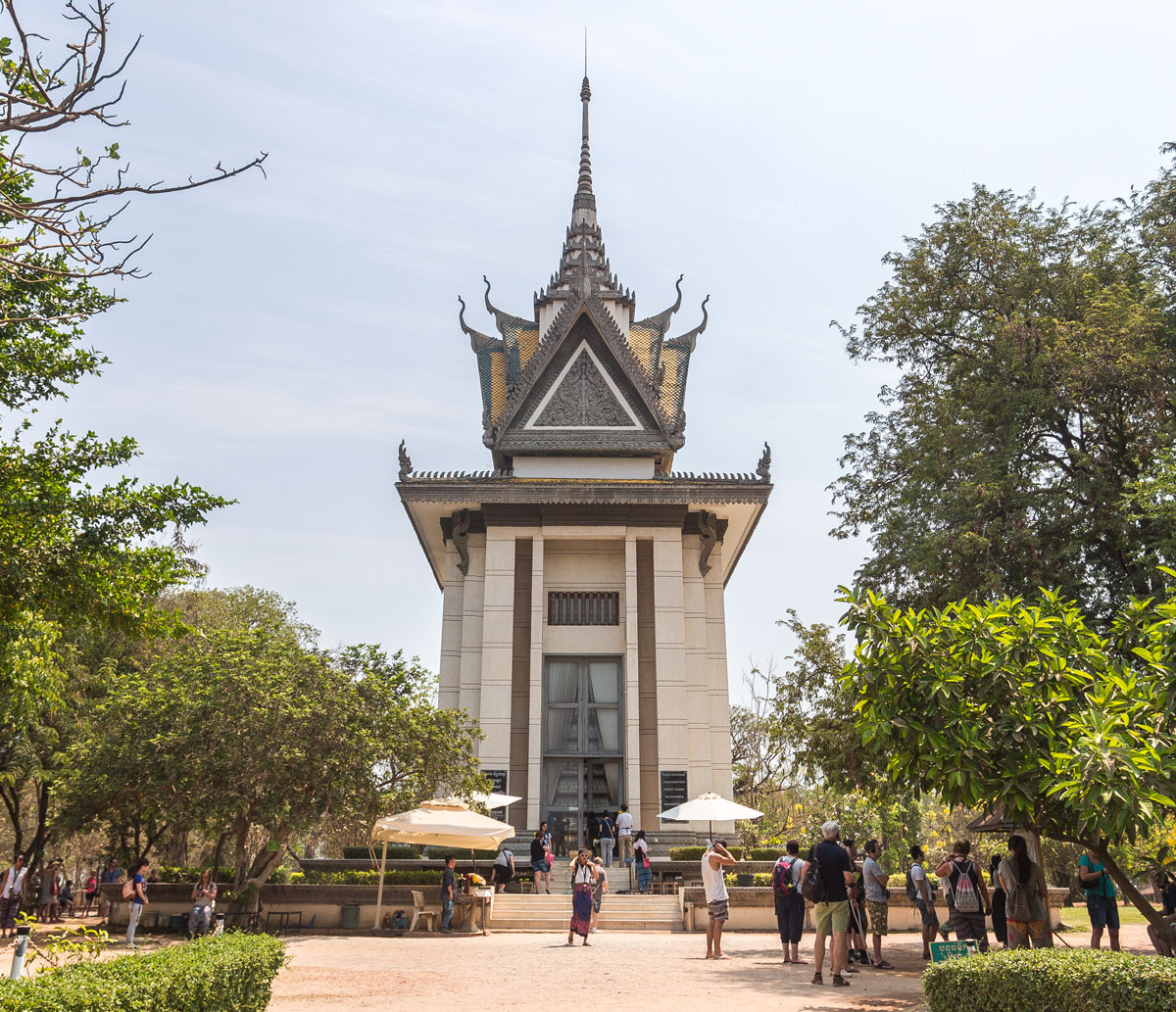
Bones lie nearby.

These pits with narrow paths between them are places of mass burials. More precisely, they are dumping grounds for corpses and even living people. All mixed together.

Some pits are fenced off and marked with the number of victims. For example, on this small patch of land, 450 people were piled together.

The Khmer Rouge dealt with people using makeshift means: smashing heads with hoes, piercing bodies with wooden spikes, and beating them to death with iron rods.
Partly, they probably saved precious bullets. Spending millions of bullets on dealing with “subhumans” would be an unacceptable luxury for a country exhausted by civil war.
But there is a more cunning reason: the weapons are too loud. The thing is, the killing fields were not located deep in the jungles, but rather quite close to cities, among villages, often between some plantations. Well, those guys hesitated to make unnecessary noise. Who knows, the locals might run away, and then it would be difficult to find them.
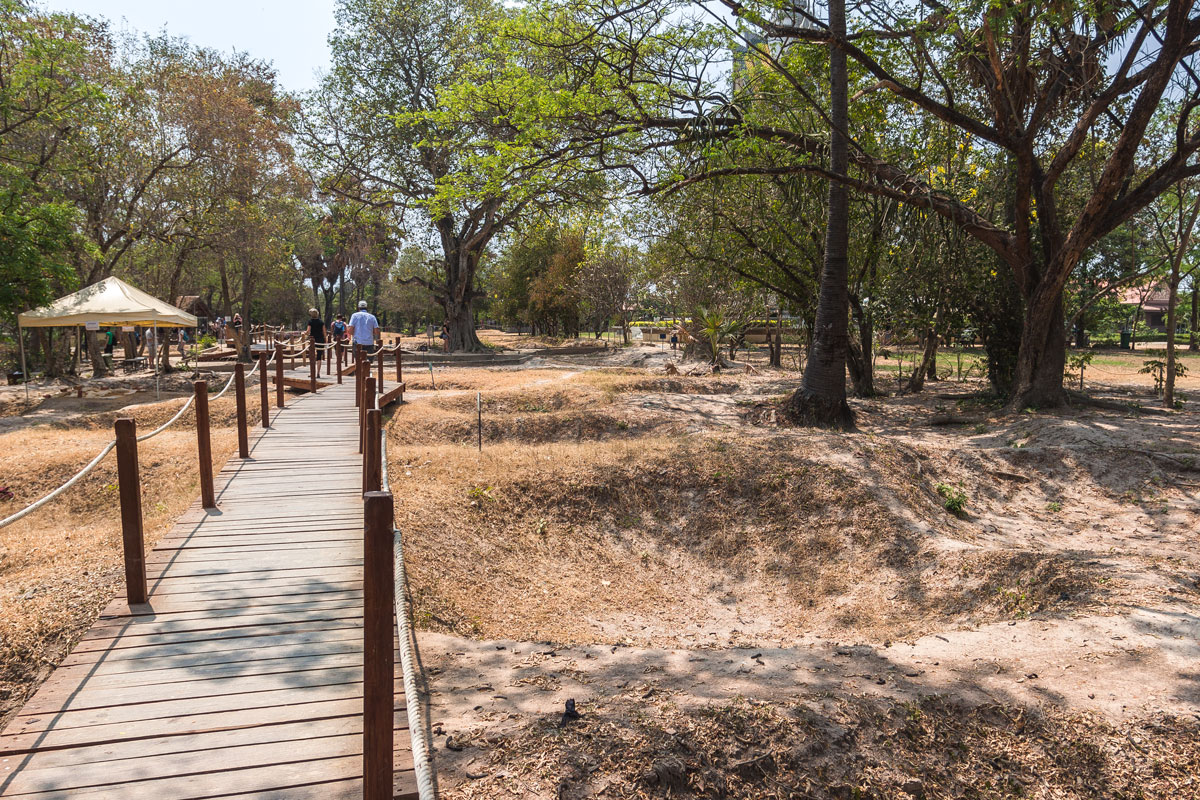
They approached noise suppression quite creatively. For example, there is a tree. It’s called the “Magic Tree” around here. On this tree hung a loudspeaker that continuously played music, drowning out the pre-death moans and cries.

To avoid the second problem – the foul smell of thousands of decaying human bodies – the Khmer Rouge used the insecticide DDT, which they poured into the pits with the corpses. In addition, DDT provided assurance that no accidental survivors would remain among the bodies.
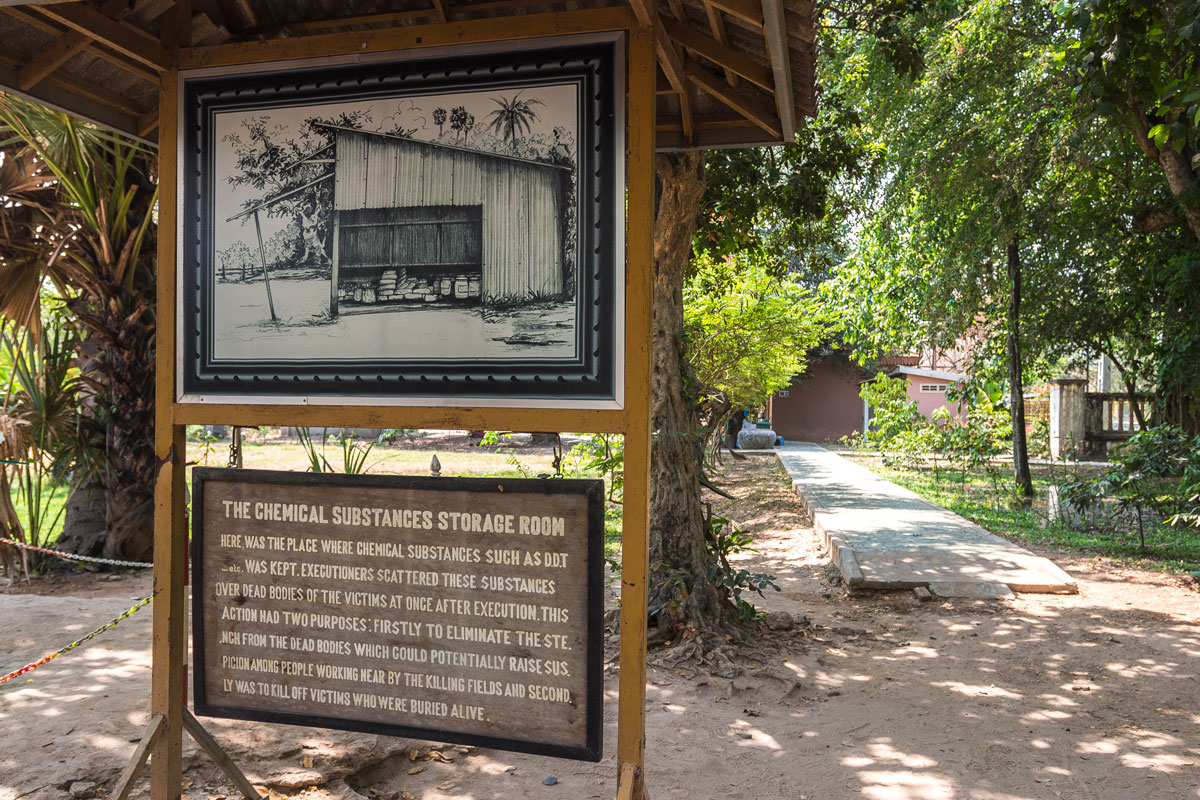
And this beautiful place near Phnom Penh is just one of the numerous sites of the Cambodian genocide. A picturesque, tranquil corner with classical national music. A free concert under the open sky, Pol Pot’s benefit with Cambodian jazz on the bones.
⁂
Let’s get back to Phnom Penh.
When on April 17, 1975, units of Cambodian communists entered the city, everyone without exception was expelled from it, and the country was named “Democratic Cambodia” (Kampuchea).
Private property was prohibited, the market was dismantled, and money was abolished. As for the people, the entire population of the new democratic country was divided by the democrats into three democratic groups.
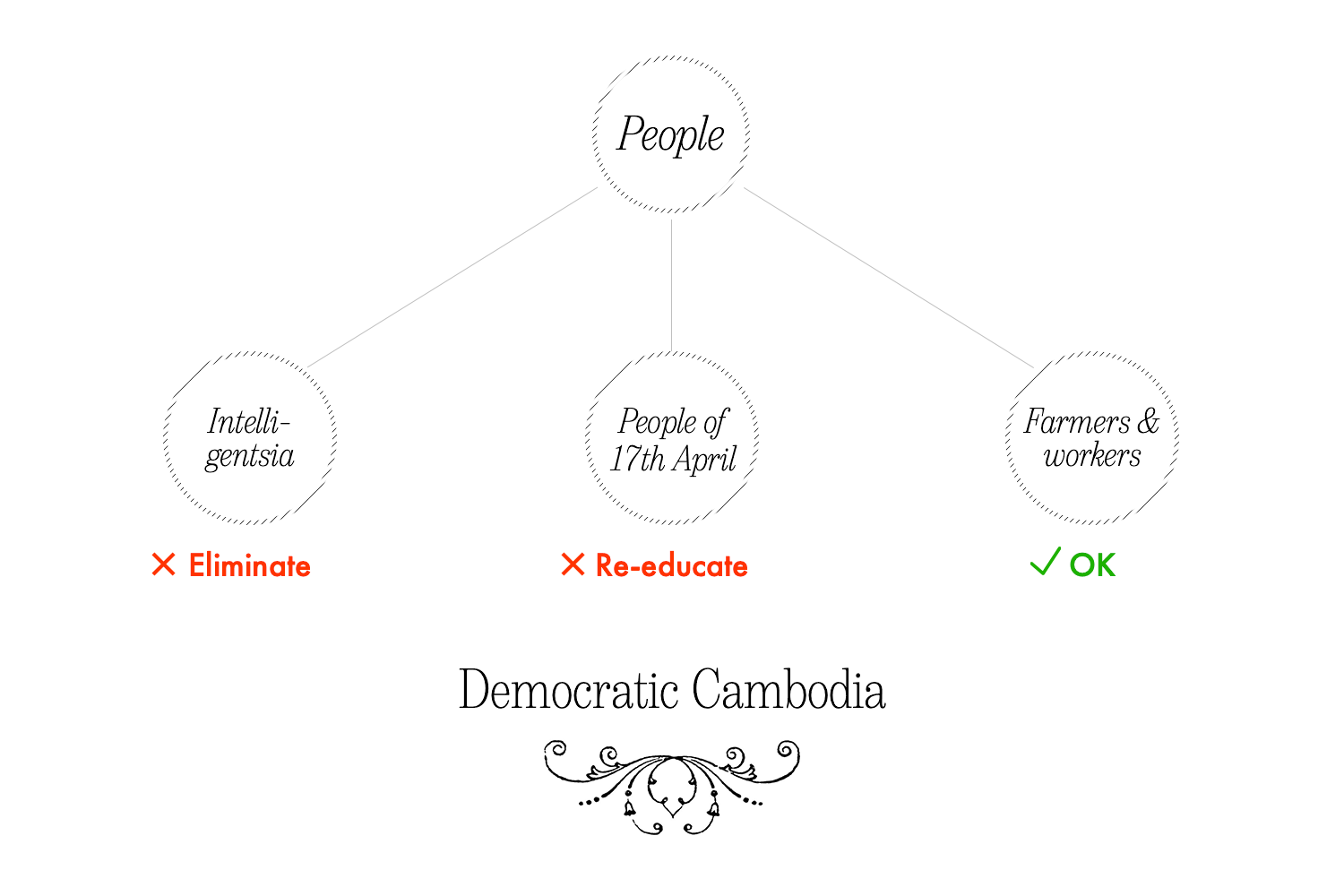
The “Base People” were the luckiest group: peasants, farmers, workers — in general, the poorest strata of the state. The proletariat, so to speak.
A special honor befell the so-called “April 17th People” — those three million individuals whom Pol Pot expelled from the cities to the rice fields. They were entitled to a program of extensive party reeducation and personal growth.
Well, the intellectuals were least fortunate once again. In this regard, the Khmer Rouge perhaps surpassed all their “colleagues” combined. No previous tyrant had dared to take such a broad interpretation of intellectuals before.
The Khmer Rouge eliminated everyone who showed any signs of intellectualism. They killed scientists and professors, brutally annihilated school teachers and medical professionals. Ground into dust temple abbots and residents of monasteries.
Those who managed to escape from the cities and disguised themselves as the “base people” also met their death while fleeing. The units of the Khmer Rouge would gather another village and carefully scrutinize all its residents. If a person had smooth hands, they would kill them. If a person wore glasses, they would kill them. If a person used technical terms, rare words, or simply spoke eloquently, what would they do? Correct: they would kill them.
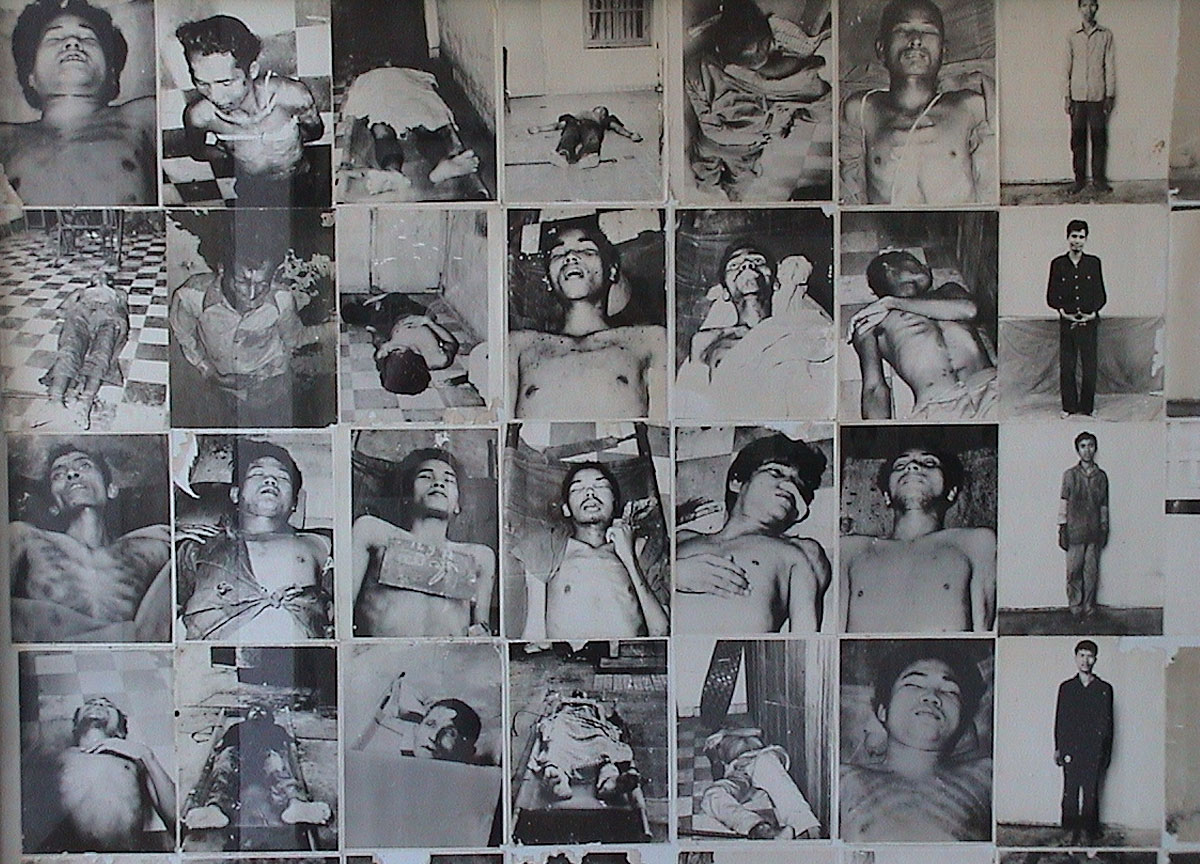
The cherry on the Cambodian cake of madness was the control over childbirth and family.
The Khmer Rouge regime attempted to destroy the traditional concept of the family. The party itself was meant to replace the family, and communal eateries were supposed to replace the kitchen as the daily gathering place for families. Under the pretext of fighting counter-revolutionary activities, people were deprived of the ability to cook food and communicate at home. They were forced to have their meals only in large public canteens where they couldn’t discuss “dangerous” ideas that were against the party.
However, such an experience existed in the USSR. Nothing new. But the Khmer Rouge went much further by initiating a struggle for procreation. Women were forced to marry and have intercourse for the purpose of childbirth. Throughout the pregnancy period, women continued to work in rice fields on a regular basis. They were only taken to hospitals during childbirth. After breastfeeding, the newborns were taken away from their mothers for party education. Those who did not give birth were not taken away, but women were sent back to the rice fields.
More than 200,000 Cambodians became victims of such violence.

In one of the buildings in the center of Phnom Penh, the Khmer Rouge established a prison and re-education center codenamed S-21. Now, this former torture site has been transformed into a genocide museum.
At the entrance, there is a crossed-out portrait made of primitive graphics, the manic physiognomy of which sends shivers down the spine. (In reality, it’s just a “No noise” sign.)

This is a former school. A decent educational institution by Asian standards.

A distinguished teacher of Cambodia is displayed on the classroom blackboard.

Remedial class for underachieving students.

The school itself can serve as a filming location for a horror movie. Everything here is left in the same condition as it was during the time of Pol Pot. The walls between classrooms are riddled and merged into a single corridor, and the classrooms are converted into brick cells where prisoners were held.

Luxury rooms with wooden finishing.
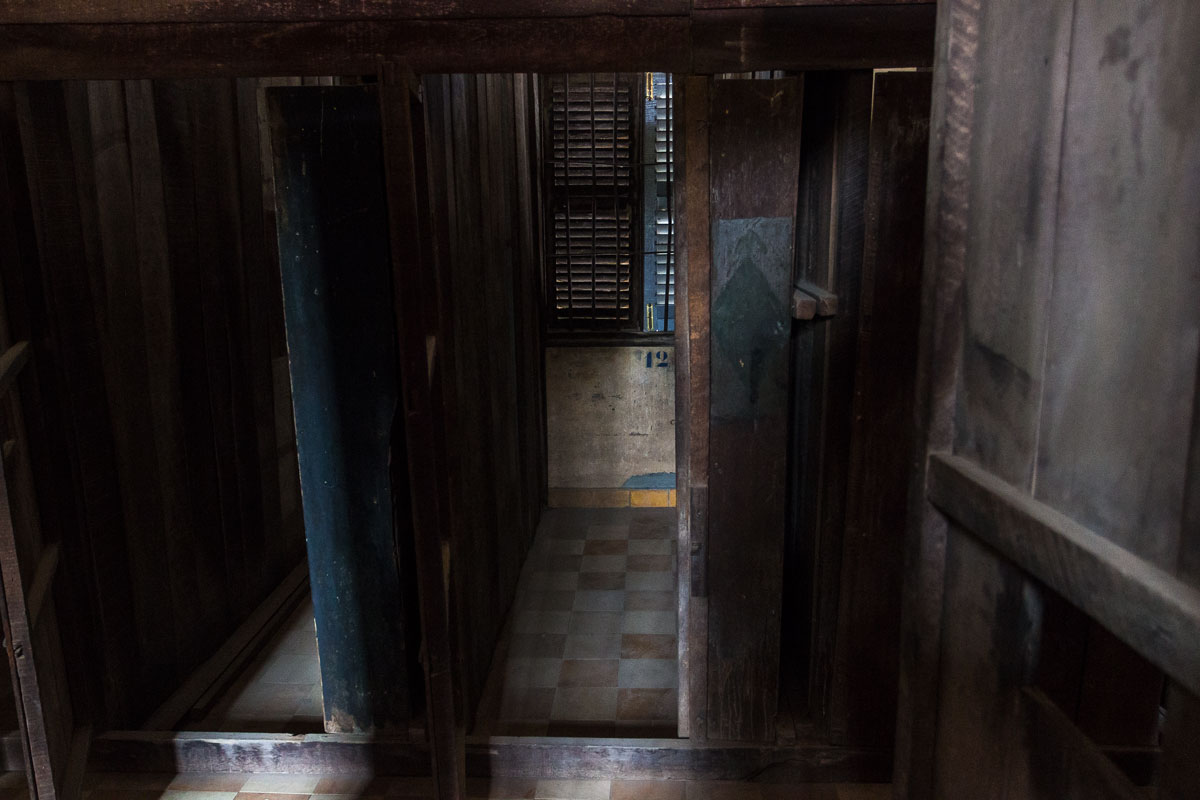
The cells could barely accommodate a person of small stature, and not everyone could stretch out lying down in these cramped quarters. Moreover, the prisoner would lie on the floor without mattresses, pillows, or even straw bedding—simply like that, on the bare floor. Wearing only underwear. Shackled to the wall with an iron chain.

In addition to solitary cells, there were also collective chambers—large rooms crammed with people. The prisoners were placed tightly next to each other. Their legs were shackled with chains attached to the floor. They still lay on the bare floor in their underwear, alternating the direction of their heads and feet.

Speaking in S-21 was prohibited. The day started at half-past four in the morning with the guards inspecting the prisoners for any broken padlocks or concealed shards that could be used by detainees to slit their throats. Throughout the existence of the prison, only a few fortunate individuals managed to accomplish this.
Food was given to the prisoners twice a day. The ration consisted of 4 spoonfuls of rice and leaf soup. Drinking water was allowed only with the permission of the guards. Showers were available once every four days with a hose. Constant interrogations and beatings, which could force confessions out of anyone, were a regular occurrence.
The set of torture methods was standard: beatings, electric shocks, branding various body parts with heated iron, suspension by limbs, suffocation with a plastic bag, nail extraction, pouring alcohol on open wounds, drowning, waterboarding, and knife cuts. In short, a typical set. Making them eat feces and drink urine was also sometimes enforced, well, if they wanted to make things even more fun.
In principle, that’s roughly how I felt in school.
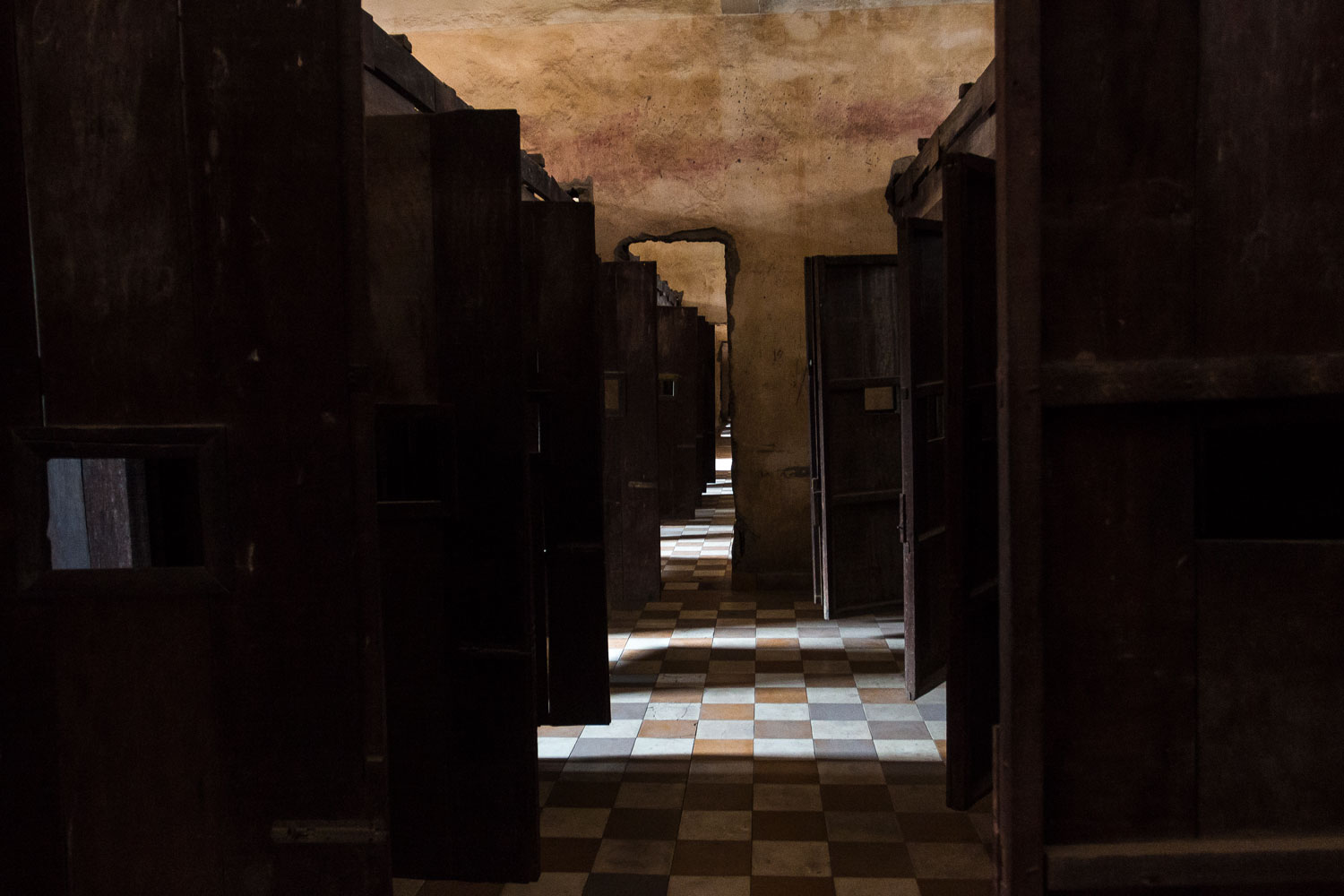
There were many such places throughout the country. This one is the most significant among them because it is located in the center of Phnom Penh.
During its 4 years of existence, the S-21 prison processed 20,000 people. Starting with former military personnel and the administration of the overthrown Lon Nol regime, it gradually began to devour academics and scholars, then moved on to teachers and doctors, followed by students and schoolchildren, and eventually started engulfing anyone who happened to fall into its clutches.
Out of the 20,000 prisoners in S-21 prison, only 7 people survived until the end of the Khmer Rouge regime. Three of them are still alive to this day.
And the “charm” of this horrific place lies in the fact that it is not just a frozen-in-time museum complex. Regular meetings with survivors of the Pol Pot regime are held on the prison grounds. Anyone interested can come to S-21 and directly ask questions to individuals who personally experienced this terrible nightmare.
Here you can meet the most famous among them, one of the three remaining prisoners of the prison. His name is Chum Mei. He survived thanks to the repair of typewriters and sewing machines — the Khmer needed him for work. Now Chum Mei sells his book “The Survivor,” and the S-21 prison still seems to be his “home”: he is here every day.

Why
Any reader who learns about Pol Pot and the Khmer Rouge asks the same question: Was this regime communist?
The question is posed sharply. To answer it, one must first understand what is generally meant by communism. If we follow the dictionary definition, the Khmer Rouge was much distant from communism — that is, a society without classes, money, and state. On the other hand, according to such a definition, the USSR had nothing in common with communism either.
If, however, communism is defined as the regime that turned out in Cambodia, and comparing it to the system that turned out in China, the USSR, and other “communist” countries, it turns out that, despite all the differences, it was the same regime.
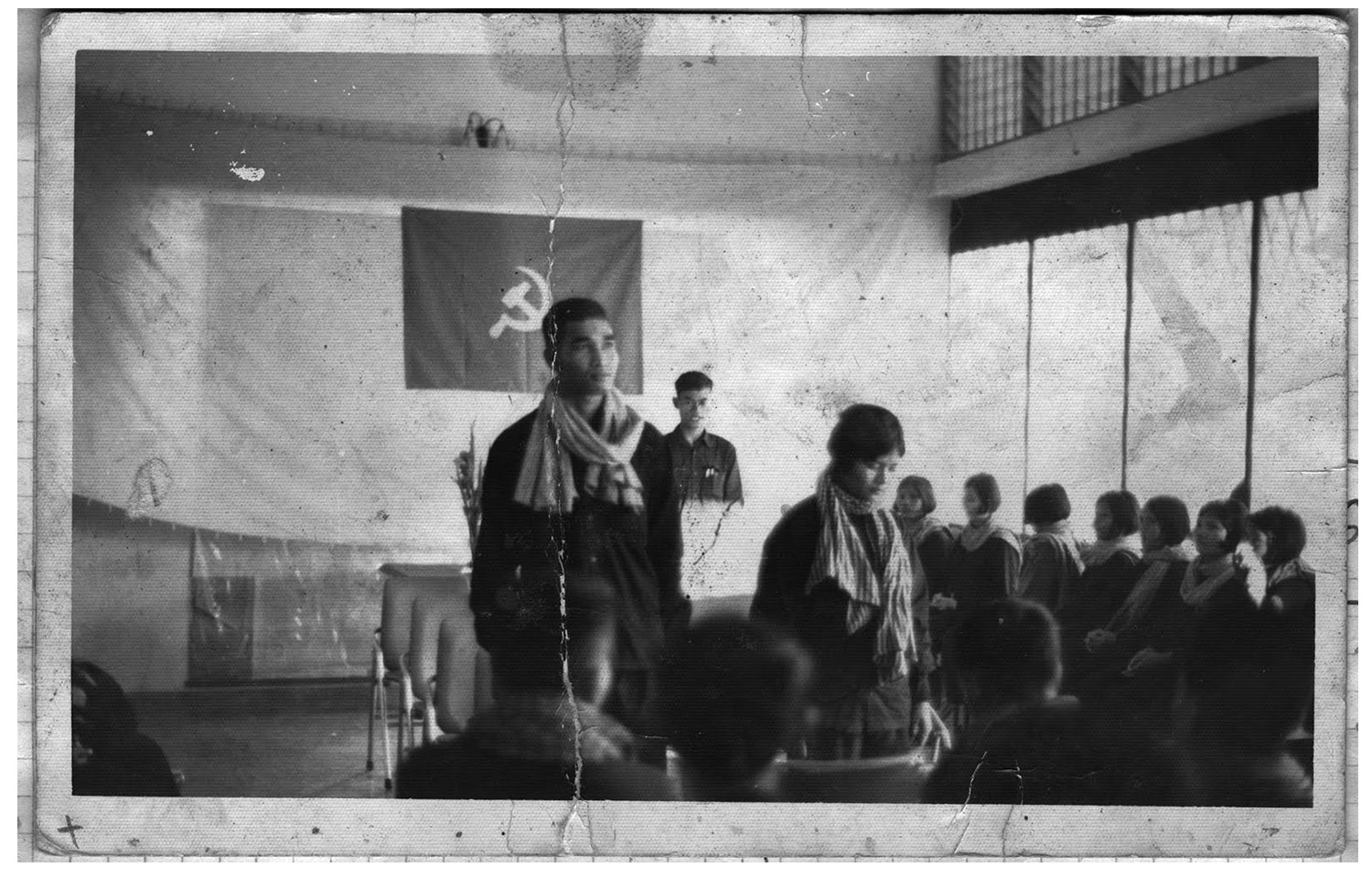
It is difficult to give a name to this regime without falling face-first into the mud. To say that it was fascism means getting involved in yet another debate about what fascism is in and of itself, and getting lost in dozens of its definitions. To say that it was the same communism as in the USSR would be rubbing salt into the reader’s wound, comparing the technical progress and achievements of the Soviet Union with the senseless killing of innocent schoolteachers in Cambodia.
But it’s also impossible to simply ignore communism. Firstly, Pol Pot was a member of the French Communist Party. Secondly, he was always inspired by Karl Marx, Joseph Stalin, and even Josip Broz Tito — the leader of Yugoslavia, where he worked on road construction for about a month.
And although Pol Pot emphasized the “uniqueness of the Cambodian revolution” in every way, we cannot dismiss his views. We must identify something common between the regime of the Khmer Rouge, communism, and perhaps fascism, Maoism, and national socialism. Moreover, this elusive commonality subtly presents itself to us.
The sought-after word is collectivism. This word is perfect in the sense that regimes in any country have never explicitly referred to themselves by this term; it is merely a generalizing term. Moreover, unlike the multifaceted nature of fascism, collectivism is defined simply and clearly. Collectivism is the primacy of societal goals over individual goals.
When comparing communism to fascism, Nazism, Maoism, Pol Pot’s regime, and other authoritarian regimes, many differences are found between them. And it is not without reason: there are indeed plenty of differences. However, the matter is far from just the differences. Hundreds of differences in the implementation of the same idea, taking into account geography and time, will not outweigh the scales if they are countered by only one but fundamental commonality. And this commonality lies in the opposition of any of these listed regimes to individual freedom.
Now it should become clearer to the reader what is common between the Khmer Rouge and Soviet communism. Stalin implemented forced collectivization and industrialization, redirecting resources and labor from the agricultural sector to the industrial one, forcing prisoners to work on the “great construction projects of communism” to boost the industry of the USSR. Pol Pot acted in the opposite way — he expelled the urban population to rice fields to boost the agricultural sector of Cambodia.
At first glance, there seems to be a chasm between two “efficient managers”: one appears to have led his country forward while the other drove his country downhill. In reality, this difference does not exist. Pol Pot similarly revitalized the economy of a deeply troubled country by redirecting the entire population towards rice cultivation, intending to sell the harvested rice and use the currency obtained for industrial development and armament. Those who refused to voluntarily submit to this plan and those who could hinder its implementation were subject to destruction. This included the Cambodian intelligentsia, scientists, monks, and all affluent and educated individuals in Cambodia who had the potential for independent thinking, gathering people around them, and defying the regime.
Thus, Pol Pot’s plan, it turns out, was not as insane as it seems at first glance. Above all, it was a plan. And it is precisely this ill-fated plan, which violated personal freedom in the name of societal goals, to achieve that illusory idea of “national survival,” that is the common thread between communism and the Khmer Rouge.
And what else but a plan can one see in this blatantly fascist quote: “In 1977, there will be two desserts per week. In 1978, one dessert every two days. And in 1979, sweet treats will be available every day”?
What else, if not a plan, was the destruction of education: “Work half the time, study half the time. Primary education will be introduced starting from 1977, and secondary education — simultaneously... to some extent”?
However, the phenomenon that planned economy in its very essence inevitably leads to an authoritarian regime and numerous victims is better described in the book “The Road to Serfdom” by Nobel laureate in economics Friedrich August von Hayek. Well, let’s return to Pol Pot.
Repentance?
The history of Pol Pot fundamentally differs from the history of other toppled tyrants like him. He did not shoot himself in his office, nor was he torn apart by a mob. Pol Pot fled into the jungle and managed to survive until our days, appearing before a rather peculiar, staged court. This is how David Chandler describes him in the book “Brother Number One.”
The crowd gathered in the open-air meeting hall began shouting slogans: “Death to the despicable traitors! Death! Death!” and “Death to the traitor Pol Pot, whose hands are stained with blood!”
Journalist Nate Taylor focused on the defendant: “Abandoned on a simple wooden chair, gripping a long bamboo cane and a rattan fan, the exhausted, weak old man tried to maintain his dignity as he watched his life crumble, enduring absolute and final defeat.”
Throughout the trial, while representatives of various “factions” presented the case materials, Pol Pot never once glanced at his accusers. After the conclusion of the legal proceedings, he was assisted in rising from the chair and escorted to a white Toyota. Pol Pot struggled to move his legs.
“As you know, the majority of people in the world hold you responsible for the deaths of hundreds of thousands of innocent Cambodians who did not deserve such suffering.”
“I will respond. I would like to tell you that I came to fight, not to kill people. Even now, as you look at me, do I appear to be a cruel person? My conscience is clear.”
“But you cannot deny that you made grave mistakes while in power!”
“There are two sides to this. There is what we did wrong and what we did right. The mistake lies in doing something against the people... but as I told you, the other perspective is that without our struggle, Cambodia wouldn’t exist today. I want you to know that everything I did, I did for my country.”
The regime of Pol Pot was overthrown by Vietnamese forces in 1979, but Khmer Rouge factions terrorized the country and fought for power until 1995. In 1994, the authorities in Phnom Penh declared the Khmer Rouge to be outlaws and initiated military actions against them.
Pol Pot died at the age of 72 on April 15, 1998, in his house in the city of Anlong Veng in the northern part of the country.
